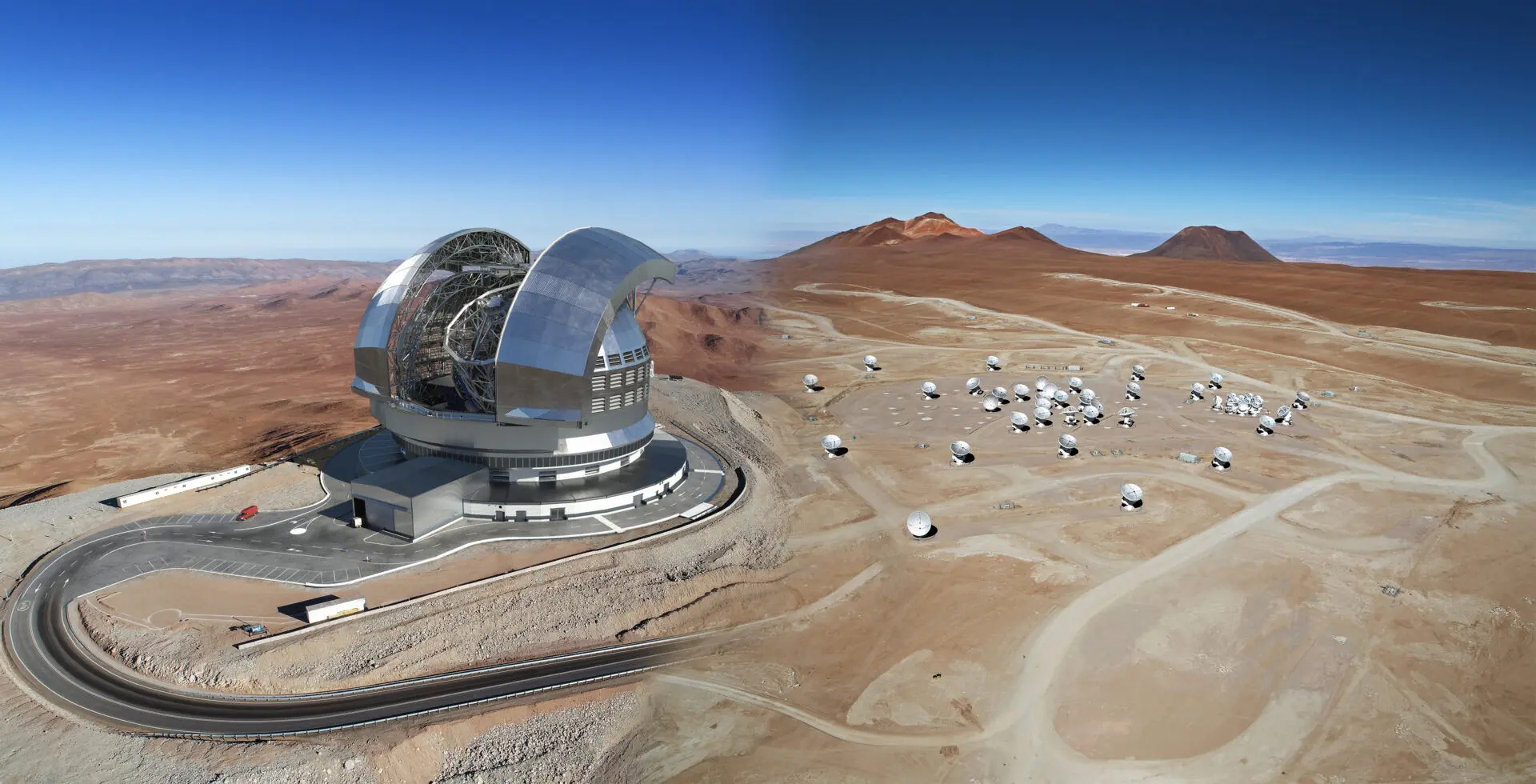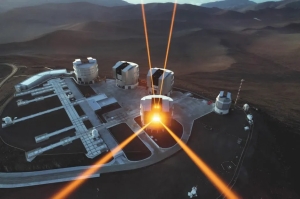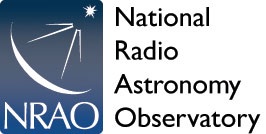
From The ESO (EU)(CL)/NRAO/NAOJ (JP)/ ALMA [Atacama Large Millimeter/submillimeter Array] Observatory (CL)
5.13.24
Nicolás Lira
Education and Public Outreach Coordinator
Joint ALMA Observatory, Santiago – Chile
Phone: +56 2 2467 6519
Cell phone: +56 9 9445 7726
Email: nicolas.lira@alma.cl

ESO ELT and ALMA. Montage: David Fernández – ALMA (ESO/NAOJ/NRAO)
All general references:
ALMA Observatory (CL) http://www.almaobservatory.org/
European Southern Observatory (EU) http://www.eso.org/public/
National Astronomical Observatory of Japan (JP) http://www.nao.ac.jp/en/
National Radio Astronomy Observatory https://public.nrao.edu/
Full identification of an astronomical asset will be presented once in the first instance of that asset.
Following an agreement awarded to the Red Universitaria Nacional (REUNA), ESO’s Paranal Observatory and ALMA will expand their global data transmission networks. The new network capacity, which runs through the Atacama Desert along the coast and mountain range of the Antofagasta region, respectively, will cover the future needs of both astronomical centers.
This agreement signed between ESO, ALMA and REUNA will increase the current capacity of the transmission system tenfold. This will continue to provide adequate connectivity to ESO’s state-of-the-art telescopes such as the Very Large Telescope and the future Extremely Large Telescope, the world’s largest optical infrared telescope, which is currently under construction.


“ESO and REUNA joined forces with the European Commission (EC) to bring the very first high-bandwidth fiber optic connection to observatories in northern Chile, thanks to EVALSO. Today we are building on that capacity, as we open the doors to other important international and national projects in the next decade with this significant concrete contribution to astronomical research in Chile,” says Andrés Vinet, Head of IT Group Chile for ESO.
For the ALMA Observatory, which is in the process of upgrading its technology for the year 2030, this will mean that it can transmit its data to its regional centers located on three continents through its new powerful capabilities.
“ALMA is undergoing a profound upgrade as part of its 2030 plan. These improvements will keep the observatory at the cutting edge of science and will require adaptations to almost all of its components. These include an increase in data transmission capacity from the Chajnantor Plateau to the various data centers operated by our partners in Europe, North America and East Asia,” says Jorge Ibsen, ALMA’s Head of Engineering.
The agreement with REUNA will run through 2034 and will increase from the current 10 Gbps to 100 Gbps. It will also give continuity to the network that REUNA has been providing since 2010. “This technological leap will enable us to anticipate the complex requirements of the different astronomical projects, not only from a scientific point of view, but it will also generate the conditions for its remote operation in real time, all in a matter of minutes—if not seconds—by facilitating the transmission of data from the north of Chile to wherever they are required, anywhere in the world,” says Albert Astudillo, REUNA’s Chief Technology Officer.
See the full article here .
Comments are invited and will be appreciated, especially if the reader finds any errors which I can correct.
five-ways-keep-your-child-safe-school-shootings
Please help promote STEM in your local schools.
The Atacama Large Millimeter/submillimeter Array (ALMA) (CL) , an international astronomy facility, is a partnership of Europe, North America and East Asia in cooperation with the Republic of Chile. ALMA is funded in Europe by the European Organization for Astronomical Research in the Southern Hemisphere (EU), in North America by the U.S. National Science Foundation in cooperation with the National Research Council of Canada (CA) and the National Science Council of Taiwan (TW) and in East Asia by the National Institutes of Natural Sciences of Japan in cooperation with the Academia Sinica (TW).
ALMA construction and operations are led on behalf of Europe by European Southern Observatory (EU), on behalf of North America by the National Radio Astronomy Observatory, which is managed by Associated Universities, Inc. and on behalf of East Asia by the National Astronomical Observatory of Japan(JP). The Joint ALMA Observatory provides the unified leadership and management of the construction, commissioning and operation of ALMA.


The antennas can be moved across the desert plateau over distances from 150 m to 16 km, which will give ALMA a powerful variable “zoom”, similar in its concept to that employed at the centimetre-wavelength Very Large Array (VLA) site in New Mexico, United States.

The high sensitivity is mainly achieved through the large numbers of antenna dishes that will make up the array.
The telescopes were provided by the European, North American and East Asian partners of ALMA. The American and European partners each provided twenty-five 12-meter diameter antennas, that compose the main array. The participating East Asian countries are contributing 16 antennas (four 12-meter diameter and twelve 7-meter diameter antennas) in the form of the Atacama Compact Array, which is part of the enhanced ALMA.
By using smaller antennas than the main ALMA array, larger fields of view can be imaged at a given frequency using ACA. Placing the antennas closer together enables the imaging of sources of larger angular extent. The ACA works together with the main array in order to enhance the latter’s wide-field imaging capability.
ALMA has its conceptual roots in three astronomical projects — the Millimeter Array (MMA) of the United States, the Large Southern Array (LSA) of Europe, and the Large Millimeter Array (LMA) of Japan.
The first step toward the creation of what would become ALMA came in 1997, when the National Radio Astronomy Observatory and the European Southern Observatory agreed to pursue a common project that merged the MMA and LSA. The merged array combined the sensitivity of the LSA with the frequency coverage and superior site of the MMA. ESO and NRAO worked together in technical, science, and management groups to define and organize a joint project between the two observatories with participation by Canada and Spain (the latter became a member of ESO later).
A series of resolutions and agreements led to the choice of “Atacama Large Millimeter Array”, or ALMA, as the name of the new array in March 1999 and the signing of the ALMA Agreement on 25 February 2003, between the North American and European parties. (“Alma” means “soul” in Spanish and “learned” or “knowledgeable” in Arabic.) Following mutual discussions over several years, the ALMA Project received a proposal from the National Astronomical Observatory of Japan whereby Japan would provide the Atacama Compact Array and three additional receiver bands for the large array, to form Enhanced ALMA. Further discussions between ALMA and NAOJ led to the signing of a high-level agreement on 14 September 2004 that makes Japan an official participant in Enhanced ALMA, to be known as the Atacama Large Millimeter/submillimeter Array. A groundbreaking ceremony was held on November 6, 2003 and the ALMA logo was unveiled.
During an early stage of the planning of ALMA, it was decided to employ ALMA antennas designed and constructed by known companies in North America, Europe, and Japan, rather than using one single design. This was mainly for political reasons. Although very different approaches have been chosen by the providers, each of the antenna designs appears to be able to meet ALMA’s stringent requirements. The components designed and manufactured across Europe were transported by specialist aerospace and astrospace logistics company Route To Space Alliance, 26 in total which were delivered to Antwerp for onward shipment to Chile.
Partners
European Southern Observatory (EU) and the European Regional Support Centre
National Science Foundation via the National Radio Astronomy Observatory and the North American ALMA Science Center
National Research Council Canada [Conseil national de recherches Canada] (CA)
National Astronomical Observatory of Japan (JP) under the National Institute of Natural Sciences (自然科学研究機構) (JP)
ALMA-Taiwan at the Academia Sinica Institute of Astronomy & Astrophysics [中央研究院天文及天文物理研究所](TW)
Republic of Chile
ALMA is a time machine!
ALMA-In Search of our Cosmic Origins
ALMA – The Rebirth of a Giant
ALMA and its Partners Celebrate 10 Years of Groundbreaking Science

